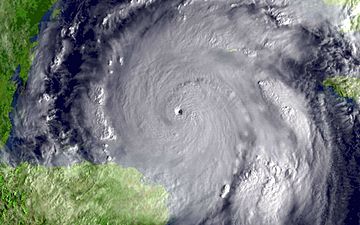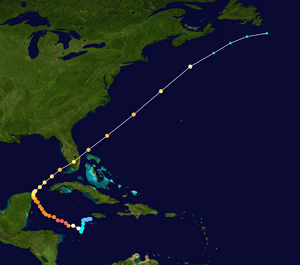Hurricane Wilma facts for kids
| Category 5 major hurricane (SSHWS/NWS) | |

|
|
| Formed | October 15, 2005 |
|---|---|
| Dissipated | October 25, 2005 |
| Highest winds | 1-minute sustained: 185 mph (295 km/h) |
| Lowest pressure | 882 mbar (hPa); 26.05 inHg (Record low in Atlantic) |
| Damage | $28.9 billion (2005 USD) |
| Areas affected | Jamaica, Haiti, Cayman Islands, Cuba, Honduras, Nicaragua, Belize, Yucatán Peninsula, Florida, Bahamas, Canada |
| Part of the 2005 Atlantic hurricane season | |
Hurricane Wilma was the most intense tropical cyclone ever recorded in terms of pressure in the Atlantic Ocean. It destroyed parts of the Yucatán Peninsula and southern Florida during October in the 2005 Atlantic hurricane season. Wilma broke several records for both strength and seasonal activity. Wilma was only the third Category 5 ever to develop in the month of October, and with its formation, the 2005 season became the most active hurricane season on record, exceeding a total of 21 storms from the 1933 season. Wilma was the twenty-second storm (including it was a subtropical storm as discovered in reanalysis), thirteenth hurricane, sixth major hurricane, and fourth Category 5 hurricane of the record-breaking Atlantic hurricane season.
Meterological history
| Rank | Hurricane | Season | Damage | ||
|---|---|---|---|---|---|
| 1 | Katrina | 2005 | $108 billion | ||
| 2 | Sandy | 2012 | $71.4 billion | ||
| 3 | Ike | 2008 | $29.5 billion | ||
| 4 | Andrew | 1992 | $26.5 billion | ||
| 5 | Wilma | 2005 | $21 billion | ||
| 6 | Ivan | 2004 | $18.8 billion | ||
| 7 | Irene | 2011 | $15.6 billion | ||
| 8 | Charley | 2004 | $15.1 billion | ||
| 9 | Rita | 2005 | $12 billion | ||
| 10 | Frances | 2004 | $9.51 billion | ||
| Source: National Hurricane Center | |||||
The meteorological history of Hurricane Wilma, the strongest tropical cyclone known in the Western Hemisphere, began in the second week of October 2005. A big weather system formed across much of the Caribbean Sea and slowly organized to the southeast of Jamaica. By late on October 15, the system had become strong enough for the National Hurricane Center to name it Tropical Depression Twenty-Four.
The depression slowly moved southwestward, and in conditions that were good for strengthening, it strengthened into Tropical Storm Wilma on October 17. In the beginning, development was slow because of its large size, although thunderstorms slowly organized. From October 18, and over the next day, Wilma underwent explosive deepening over the open waters of the Caribbean; in a 30-hour period, the system's central atmospheric pressure dropped from 982 mbar (29.00 inHg) to the record-low value of 882 mbar (26.05 inHg), while the winds increased to 185 mph (300 km/h). At its strongest, the pinhole eye of Wilma was about 3 miles (5 km) in diameter, the smallest known eye in an Atlantic hurricane. After the inner eye died off because of an eyewall replacement cycle, Wilma weakened to Category 4 status, and on October 21, it made landfall on Cozumel and on the Mexican mainland with winds of about 150 mph (240 km/h).
Wilma weakened over the Yucatán Peninsula, and reached the southern Gulf of Mexico before speeding up northeastward. Despite increasing amounts of wind shear, the hurricane re-strengthened to hit Cape Romano, Florida as a major hurricane. Wilma weakened as it quickly crossed the state, and entered the Atlantic Ocean near Jupiter, Florida. The hurricane again re-intensified before cold air and wind shear penetrated the inner core of convection. On October 26, it turned into an extratropical cyclone, and the next day, the remnants of Wilma were absorbed by another extratropical storm over Atlantic Canada.
Related pages
|
Tropical cyclones of the 2005 Atlantic hurricane season |
|||||||||||||||||||||||||||||||||||||||||||||||
|
|
||||||||||||||||||||||||||||||||||||||||||||||
|
|
|||||||||||||||||||||||||||||||||||||||||||||||
Images for kids
-
Radar image of Hurricane Wilma making landfall in South Florida
-
Storm surge from Wilma on Key Haven, island suburb of Key West, Florida
-
Federal Emergency Management Agency (FEMA) Disaster Medical Assistance Team checks a patient outside of the JFK Medical Center (Boynton Beach). The DMAT is set up in the entryway of the hospital to assist in seeing the increase flow of patients due to Hurricane Wilma.
See also
 In Spanish: Huracán Wilma para niños
In Spanish: Huracán Wilma para niños









